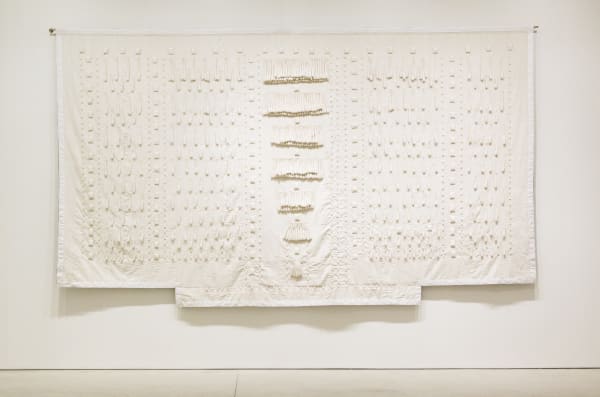Solo show: Abdoulaye Konaté
"The final message for me is the call to tolerance. Stimulate men in accepting and understanding the others. This is the only possible solution to our society problem ".
Primo Marella is proud to present in his gallery venue one of the most influent and importan artis of the african world: Abdoulaye Konatè. At his second solo show in Milan, symbol of a fruitful and happy collaboration.
Born in 1953, Abdoulaye Konatè first studied painting at the National Institute of Arts in Bamako. When he later moved to Cuba (1978-1985) he met the artist Wilfredo Lam, who brightly asked him: “"Why are you coming here to show me what you have done in Cuba, when you have everything you need at home?”.
At the comeback in Mali, Abdoulaye embrace the suggestion: he left painting in favour of textile cotton as expressive medium.
This kind of liguistic choice is linked to an active effort towards knowledge: cotton stripes, weaved and embroided, become his signature. The exploration extends even to dyes and colours. On one side the artist developes the indigenous cotton tradition and on the other side he uses it, not with a decorative aim but, as a symbol and concept of his work. This feature can be interpretated as a commitment that the artist keep to recover not only his memory but also his country beliefs, matching handcraft tradition with the political world. Declaring himself interested in social relationships, both as internal in the society and in a family unit, Abdoulaye reinterprets strong political themes, like arabian-istraelian conflict; mines problem; Ruanda genocide and human rights.
During the years the artist has been interested also in issues about deforestation and natural environment. As proof of such a strong commitment, in 2008, Abdoulaye has been mentioned for the prize “Artes Mundi”, an honour for particular committed artist in social themes.
Regarding his artistic investigation, Konatè says:
"[…] In my art coexist two extremly different schools of thought: on one side there is the aesthetic, influenced by nature and cultural traditions of my country, which determines colours and materials used in my artwors. On the other side there is a more spiritual level borning from the will of investigate and describe human suffering, which could be found in countries’ relationships, politic, environment, society and in the family itself".
In the Milan solo show two very ambitious and huge artworks are presented: Pouvoir et Religion (2011) and Gris Gris Blanc avec Personnage (2013).
Pouvoir et Religion has been commissioned by INIVA (Institute of International Visual Arts) for the window in Rivington Place, London. INIVA’s focus is on artistic languages out of the ordinary occidental standards. The artwork Pouvoir et Religion has been later showed at the Art Museum in Norrköping, famous textile city in Sweden.
In this big textile artwork there are hundreds of cotton stripes laying in seven metres length. Thanks to their position they create a sort of three-dimensional and “plumed” effect, which remind to a peacock plumage – animal with a strong symbolistic meaning for sub-saharian Africa.
In the piece we can recognize three sections where there are a crown, a cross and a half moon, with such graphic arrangement, Abdoulaye explores the position of Christianity and Islam inside political and cultural life.
In the artwork Gris Gris Blanc (avec Personnage), Abdoulaye uses cotton in an original way. The white cloth shows the ritmic repetition of Gris Gris (charmes) which remind to the small ones stitched on the Banama hunters’ tunics, with the aim to prevent from pain and danger.
This particular brotherhood is special for Konatè because of its spiritual and cultural wealth.
In the hunters’ habits gris gris often contain therapeutic plants or even soil to give protection. In this artwork they are left empty and they stands for relationship between physical and spiritual world.
In effect, like charms give power to hunters, they also give power to the artwork.
In 1994 Abdoulaye had already accomplished the work “Tribute to Mande Hunters” in which he first honoured the Banama hunters using their clothes adorned with shells, wood, boned and other materials.
In the later artwork Gris Gris Blanc (avec Personnage) the absence of colours call at mind his pictorial education - mainly abstract – and at the same time increases the symbolism of the elements.
The three-dimensional side it’s a clear reference to the hunter’s cloak and links to Mali heritage an intellectual and associative value.
As suggested by Tessa Jackson: "Is the artist reminding us, in our fast moving technologically orientated world, that art is a vital site for necessary spiritual reflection and enquiry? In mocking up a figure as part of Gris Gris Blanc (avec Personage),he seems to suggest that we must keep alive our spiritual heritage as well as our physical heritage”.














